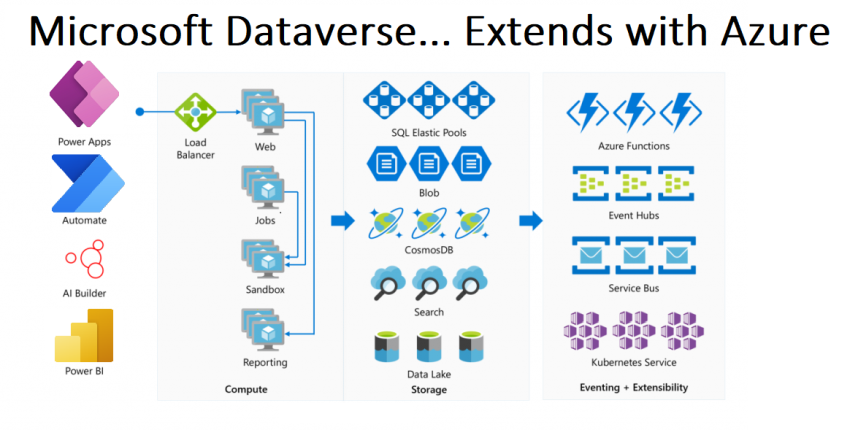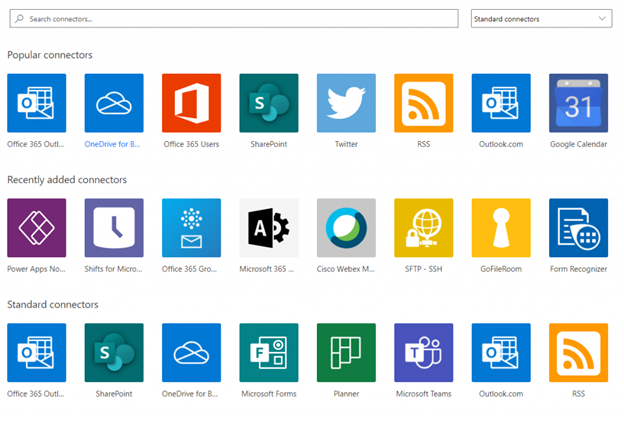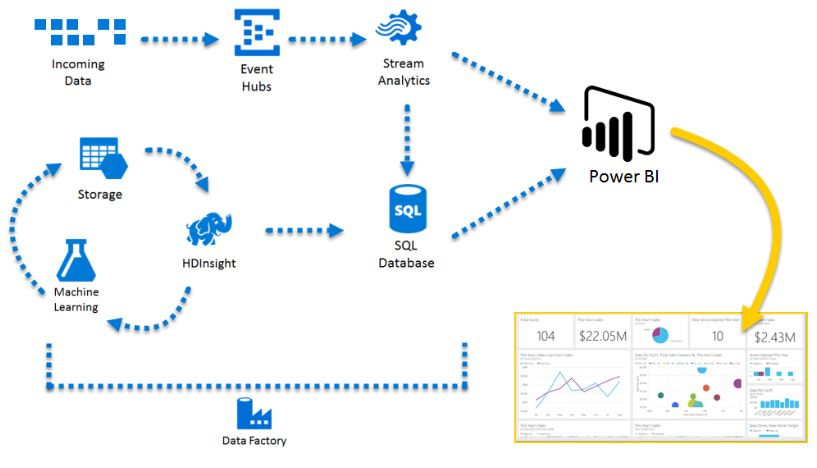Have you ever wondered what your business landscape will look like if you could automate processes that are manually made in sheets, thereby saving time and the potential to maximize profitability?
This futuristic innovation is now a reality!
Historically, the IT and development teams were responsible for the creation and automation of data, while routing it through the approval stage before getting started. This consumes time and resources, with added delays and prolonged feedback loops, which results in stagnant growth charts.
With the deployment of Microsoft Power Platforms, a futuristic low-code development solution, organizations and enterprises continue to speed up the digital business transformation journey. Blending data manipulation, surfacing, automating, and analyzing data allows for the inter-operation of data applications and services for unified and simplified data schemas.
Microsoft Power Platforms – Creating a Convenient Future
Microsoft defines Power Platform as a low code platform that enables organizations to analyze data, act on its applications, and automate business processes. It allows everyone, from the professional developer to the front line worker, to participate in driving better business outcomes by building apps.
Innovation anywhere, Unlocks value everywhere!
The businesses have now entered the digital arena where they are evolving into an IT landscape. With the encapsulation of newer technologies that envelop the digital disruptions to enhance business efficiencies, businesses can now optimize efficiencies.
This article, along with the infusion of Microsoft Power Platform, helps craft an outline that makes it convenient and effective for the business to route towards success. In that aspect, we will be covering the constituents, core components, benefits, and challenges of Power Platform. Along with that, readers will get an insight into this revolutionary low-code solution as retail industries leverage AI and data-driven capabilities to keep the growth momentum swinging.
Constituents of Microsoft Power Platform
Microsoft Power Platform consists of four core components to add to its robustness and scalability. Power BI, Power Apps, Power Automate, Power Virtual Agents, and Power Pages are dynamic in themselves and even more smart and innovative when used collectively.

Let’s look at them, in a little more detail:
Power BI
Power BI is a business analytics service aimed at delivering structured insights to analyze data. Data visualization helps with formulating reports and dashboards to enable quick, convenient, and informed decisions.
With the ability to smoothly scale across an organization, it features built-in governance and security allowing businesses to focus on deploying data more than managing it.
- Connects with Microsoft, third-party cloud services, and local data sources
- Can easily manipulate data and create visual elements to present data in an easy-to-digest format
- Use natural language to query data and get result
- Analyzes complex data to enable continuous improvement
Power Apps
Power Apps is a low-code application development tool that aims at fulfilling business needs. This includes streamlining operations and transforming innovations into operational solutions via feature-rich low-code application development tools.
The inclusion of services, connectors, scalable data services, and Microsoft Dataverse, allows for smooth integration and interaction with existing data. These specially developed Power Apps are eligible to run smoothly on the web and mobile conveniently.
- Create mobile-optimized apps quickly without development knowledge
- Connect and visualize data from your enterprise apps such as Dynamics 365 and Office 365
- Visualize key data in an intuitive app for easy data entry
Power Automate
Power automation allows businesses to create automated workflows between applications and services. This helps eliminate repetitive and monotonous tasks via the creation of enterprise-grade process automation. The unique, and simple-to-use interface allows users to automate work tasks, thereby enhancing user experience.
Power Automate will handle every aspect of machine management for you, helping you focus your time where it is needed most.
- Use predefined automation templates for common automation
- Create your own automation by linking apps
- Set up triggers, alerts, automated emails, push notifications, and more, without coding and in minutes
- Saves you time by reducing human error and streamlining your business processes
Power Virtual Agents
Power Virtual Agents allow users to create powerful chatbots via a guided, no-code graphical interface, without any need for data scientists or developers.
Deploying Power Virtual Agents helps maintain a custom solution by building and maintaining their own conversational solutions. By seamlessly integrating the legacy system with the Microsoft Power ecosystem, users can enable chatbots to perform actions to automate activities or call-back end systems.
- adds sophisticated functionality at each step
- flexible tool driving continuous improvement
- easy integrations drive power and value
- Replaces monotonous tasks with automation and features advanced searches for guided conversations
Power Pages
Power Pages combine low-code capabilities and experiences that can empower anyone to create and deliver business-centric, data-powered, modern, and secure websites.
Power Pages is built for low-code makers and professional developers alike. Dive in with code-first capabilities with seamless integration with Visual Studio Code, GitHub, and Azure DevOps. Not only do these integrations enable developers to implement advanced business requirements, but they also empower them to automate their development workflow and leverage continuous integration and continuous deployment (CI/CD) practices.
- Helps develop low-code, fully functioning apps quickly
- Runs upon Microsoft Azure, promising encryption, and user roles to secure information
- Customizable templates full of advanced features, holding sample data for you to test the functionality
- Design studio environment for creation, including video, form, and list modules
Core Components of Microsoft Power Platform
Microsoft Power Platform, as the name suggests, is a comprehensive platform infused with a range of components. Yet, for optimal performance, they are synergized together with the inclusion of core components like AI Builder, Microsoft Dataverse, and Connectors allowing for optimal performance.
Global companies continue to embed the Microsoft Power Platform to transform the application development process. Microsoft Annual Report 2021 reflects over 16 million monthly business users of the Power Platform, deploying it to automate workflows, create apps, build virtual agents, and analyze data for revolutionizing productivity for knowledge workers.
Here is a look at some of the core components of the Microsoft Power Platform to add robustness and scalability.
AI Builder
AI Builder lets users and developers add AI capabilities to the workflows and Power Apps they create and use. AI Builder is a turnkey solution that allows you to easily add intelligence to your workflows and apps and predict outcomes to help improve business performance without writing code.
Moreover, AI Builder makes binary classification simpler and more convenient. Data classifications ranging from binary classification, text classification, object detection, and form processing simplifies the process. These classification models detect learned patterns in new data to predict future outcomes.
For instance, in a retail setup, it simplifies inventory management and shifts the employee’s focus on on-site customer relationship building. Similarly, in the manufacturing industry, object detection allows locating, counting, and identifying selected objects in any picture. This helps the manufacturers speed up their repair process by saving their time manually searching for the product.
Nevertheless, AI Builder converges with Power Platform products to streamline business operations. For instance, Power Automate’s document automation empowers your organization to streamline tedious manual tasks and extract relevant information from any kind of print or digital form.
Microsoft Dataverse
Microsoft Dataverse is a scalable data service and app platform which lets users securely store and manage data from multiple sources. It also allows them to integrate that data into business applications using a common data model to ensure ease and consistency for users.
The full-featured extensibility of the Microsoft Power Platform allows development professionals to explore data possibilities and share them with the entire organization. Although, building the entire data infrastructure ground up becomes time-consuming and an expensive task, Microsoft Dataverse’s no-code/low-code solution drives business action. It further empowers organizations to gain valuable insights while working with any type of data or app at a global level.
Microsoft Dataverse is the common currency that enables the components of Microsoft Power Platform to seamlessly work together. It’s the foundation that enables the consolidation, display, and manipulation of data. Knowing that it’s built on Azure, organizations choosing Dataverse can be confident that it’s globally available, compliant, scalable, and secure.

In all, Microsoft Dataverse provides relational data storage, rich data types, enterprise-grade governance, and one-click solution deployment.
Connectors
Power Platform connectors enable you to connect apps, data, and devices in the cloud. Consider connectors as the bridge that transfers the information and commands from one end of the organization to the other end. There are more than 600 connectors for Microsoft Power Platform, enabling all your data and actions to connect cohesively.

It further enriches portals with model-driven forms, views, lists, charts, and dashboards to offer more value with each interaction. With an intuitive interface and step-by-step guidance, it helps create and manage the content for external users and partners.
Ranging between either public or custom connections, they make triggers and actions to be used by the apps and the flows to perform a defined set of actions during the execution.
Thereby, enabling anyone to build responsive websites, engaging with external customers and partners, while integrating the holistic data.
Benefits of Using Microsoft Power Platform
Microsoft Power Platform has a holistic application suite; composed of Power BI, Power Apps, Power Automate, Power Pages, and Power Virtual Agents to ensure smooth functionality for all enterprise users. So much so, that the global digital transformation is expected to increase at a compound annual growth rate of 16.5%, totaling up to $1.009.8 billion in 2025.
While most businesses have invested in the individual utilization of these components, the products and components can further be unified to significantly improve operations.
Manages Business Processes Holistically
Microsoft Power Platform showcases an enterprise-grade platform to help manage all sorts of data, with the deployment of multiple, disparate tools for generating value-added data in a singular dashboard.
Tailored Solutions to Meet Customer Needs
Microsoft Power Platforms strives to simplify business operations. With code-free design capabilities, it reduces the need for technical proficiency to design and develop business applications to troubleshoot redundancies.
Lowers Dependency on Third-party Tools
Microsoft Power Platform infuses together analytics, design, development, and automation tools for effective utilization. This reduces the need for maintenance subscriptions, cost controls, and stressing over the business inefficiencies.
Seamless Office 365 Integration
Microsoft Office 365 effectively integrates with legacy systems and Microsoft Power Platform to manage enterprise data while simplifying business processes and tasks.
Enables Working Capability on-the-go
The new tech era has demonstrated the ability to operate digitally and the significance of digital integration in coming workflows. Many older apps cannot fully manage the integration of online and mobile applications. However, with the Microsoft Power Platform, businesses can always communicate with their remote team members and effortlessly access your project activity regardless of the devices you use.
Improves Data Security
The Microsoft Power Platform’s integrative capabilities enable the entire business data to be kept in a single, highly secure location, making it the single source of truth for your organization. More so, Microsoft products are created in IRAP-certified Azure data centers from Microsoft to ensure that they stay fully protected thereby guaranteeing the highest levels of cyber and data security.
In essence, the Microsoft Power Platform helps simplify business processes and reduces the workload optimally.
Revolutionary Low-code Solution for Digital Transformation
Digital transformation is growing at an incredible speed. Organizations continue to adopt low-code tooling methods to process business-critical solutions and accelerate change. The inclusion of the Microsoft Power Platform helps automate processes, build solutions, analyze data, and create virtual agents. Together, it envisions increased flow and efficient use of data for an impactful customer-centric digital business transformation. In all, developing a digital-first company culture delivers an exceptional customer experience.
In the recent tech-savvy world, many organizations believe that their data is not being used to its full capacity. Initially, the concern was mainly placed on the data collection mechanisms. Fast forward to the time nowadays, organizations seek solutions to the creation of data culture to generate meaningful data for users, and systems to make it work. This harnesses data and gains insights to drive business processes that are intelligent, thereby bringing Power Platform to seamlessly fit into your business.
Businesses of today’s era, look forward to harvesting the AI data-driven insights for unlocking the untapped funnels in the data transformation process.

Infused with pre-built models of advanced capabilities and trained machine learning modules from Azure machine learning, visual representation appears for the user with all the necessary details to take the next step. With a vision to provide strong techniques to extract data from various sources, identify keywords, and detect languages, users, and organizations, its available for a variety of purposes.
Power Pendulum Continues to Swing
Businesses are becoming well-versed with the growing potential of deployment of low-code applications under the Microsoft Power Platform to manifest unprecedented tech literacy. The total amount of data being created, captured, copied, and consumed globally is forecasted to increase at a rapid pace to reach 180 zettabytes by 2025. A major chunk of this growth reflects in the inclusion of Powerful Platform as businesses continue to embrace low-code development solutions to showcase a clear momentum in the marketplace, with data accuracy and value.
The inclusion of the Microsoft Power Platform brings value to business organizations in several ways including:
- Business-specific solutions for organization-level scalability
- Custom-app creation to aid the entire workforce
- Rapid solutions to meet urgent business needs
- Driving automation, digitization, and process involvement
- Dashboards and data visualization for adequate decision-making and reporting
- Continuous innovation and improvement (term update)
Challenges entailing Power Platform for Business Process Automation
Implementation of Microsoft Power Platform helps to eliminate the manual, time-consuming and costly tasks and automate them to reduce overall business inefficiency and operating costs. Designed to provide the companies with compelling and competitive advantages, it elevates business performance, simplifies compliance management, and enables easy adoption/maximization of capabilities, while taking advantage of the oncoming AI revolution.
Nevertheless, there continue to be some challenges that deter seamless automation, for instance:
- On-premises to Public Cloud: Replicating on-premises concepts and mindsets
- Built for IT: Centralized and process-driven cloud adoption instead of agile innovation on power platforms
- Architecture Complexity: Struggling to translate requirements to power platform concepts, capabilities, and constructs
- Security, Governance, and Compliance: Either an afterthought or a blocker
Yet, all those businesses can successfully swim past these turbulent waves of implementation and execution stages while routed towards success.
Power Platform: Leveraging Retail Capabilities
Power Platform is just one of the phenomenal components from Microsoft’s Stack, consistently routed towards optimizing business processes and operations with minimal hardcore technical capabilities.
Similarly, Microsoft continues to innovate with the retailers to help them embrace their biggest opportunities. It enables intelligent retail by empowering businesses to take control of their digital evolution. Nevertheless, it is forecasted that the global annual spending on artificial intelligence by retailers will top $7.3 billion by 2022. And embedding power platform solutions will pace technology at the forefront to deliver an intelligent supply chain that reimagines their businesses.
Microsoft products like Azure Synapse Analytics help retailers surface actionable customer insights to analyze vast amounts of data and apply machine learning to surface insights and drive immediate impact on businesses. Similarly, Dynamics 365 Customer Insights maximize customer lifetime value by surfacing a 360-degree view of the customer to drive personalized engagements at scale. Dynamics 365 Commerce provides a true multi-channel solution that transforms the customer experience by unifying retailers’ back-office, in-store, call center, and e-commerce experiences.
Together, it creates more personalized engagement with customers, employees who are better equipped to provide the best customer experience possible, and deep insights to empower advanced decision-making across every piece of a retailer’s business.
Microsoft Power Platform- More than You Can Think
If businesses are going to use these applications for real-world, production-level uses, then they need to work together. The Power Platform is Microsoft’s promise that these applications will work together not only today but, in the future, as well. Microsoft places Power Platform as the extensibility of Office 365 beyond making and reading toward gathering, analyzing, and utilizing data. It also pitches the Power Platform as a perfect companion to its Azure Platform. Together these pieces allow companies to create usable analytics, powerful applications, and automated workflows, all at the user level without ever involving the technical aspects like coding.
It’s a bold promise, one that will be a big deal for companies on the Microsoft platform moving into the future.

Image: Data services, azure services are converged with developer tools, all integrated with PP as the next level of abstraction on top.
While working on the implementation of the Power Platform, developers no longer must build everything from the ground up. They can use a mature scale platform to go a lot faster, and write the code where it’s most needed, which means more progress and faster more consistent outcomes across the board. Microsoft stack is built for this level of collaboration, it is more than the low-code solution and begins from a powerful data layer.
Dynamics Solution and Technology- Your Way Ahead!
We live in a data-driven world, where businesses can find it difficult to take advantage of the data you have access to. Sales, customer, and employee data should drive your business decisions, but where do we even start? Microsoft Power Platform can add value to any business by helping you to analyze, act, and automate.
Nevertheless, finding a suitable implementation partner, with adequate industry, customer, and market knowledge, can be a daunting task.
That’s why you don’t have to do it all alone. Whether you are expanding your business or upgrading your on-premises system to Microsoft D365, our functional experts will help untap the hidden potential while routing towards success.
Dynamics Solution and Technology has a diverse team of certified consultants that can help deploy the Microsoft Power Platform and get started and help accomplish the set objectives for reaching out to the ultimate success with your digital business transformation journey.
If you would like to discuss the potential of the Power Platform, how to get started, or a specific project, then get in touch!







